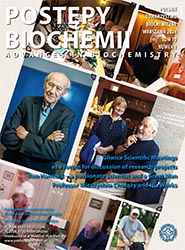Self-organisation of early stress response in the biology of cancer
DOI:
https://doi.org/10.18388/pb.2021_521Abstrakt
The early stress response by AP-1 (FOS/JUN), supported by upregulation of c-Myc and
involved in cell-fate changes and adaptation to hostile environments, is increased in cancer.
The review shows the biphasic character of this response with negative feedback typically
lasting a few hours as a feature of the genome regulation by self-organising criticality.
It involves the rapid splitting of the pericentromeric heterochromatin clusters, the opening
of the active chromatin, and a massive transcription acceleration wave. Phylostratigraphic
analysis revealed that AP-1 genes evolved in the Cambrian explosion ~500 Mya integrating
the protein interaction networks of reproduction including proto-placenta intertwined with
cytokine and immunity pathways, sex determination, oocyte maturation, and embryonal
stemness. The peak of this response as part of accelerated cell senescence led by AP-1 and
IL-1β was found in the breast cancer cell line resistant to doxorubicin. The adaptability of
aggressive cancer to treatments can be explained by emergent stress response evolutionarily
protecting reproduction.
Opublikowane
Licencja
Prawa autorskie (c) 2024 Jekaterina Erenpreisa, Kristine Salmina, Ninel M Vainshelbaum, Inna Inashkina, Talivaldis Freivalds

Utwór dostępny jest na licencji Creative Commons Uznanie autorstwa 4.0 Międzynarodowe.
Zawartość kwartalnika jest rozpowszechniana na licencji Creative Commons Uznanie autorstwa 4.0 Międzynarodowe (CC BY 4.0). Uznanie autorstwa — Utwór należy odpowiednio oznaczyć, podać link do licencji i wskazać jeśli zostały dokonane w nim zmiany . Możesz to zrobić w dowolny, rozsądny sposób, o ile nie sugeruje to udzielania przez licencjodawcę poparcia dla Ciebie lub sposobu, w jaki wykorzystujesz ten utwór.
Prawa autorskie do prac © pozostają przy autorach.
Prawa autorskie do czasopisma © posiada Polskie Towarzystwo Biochemiczne.




